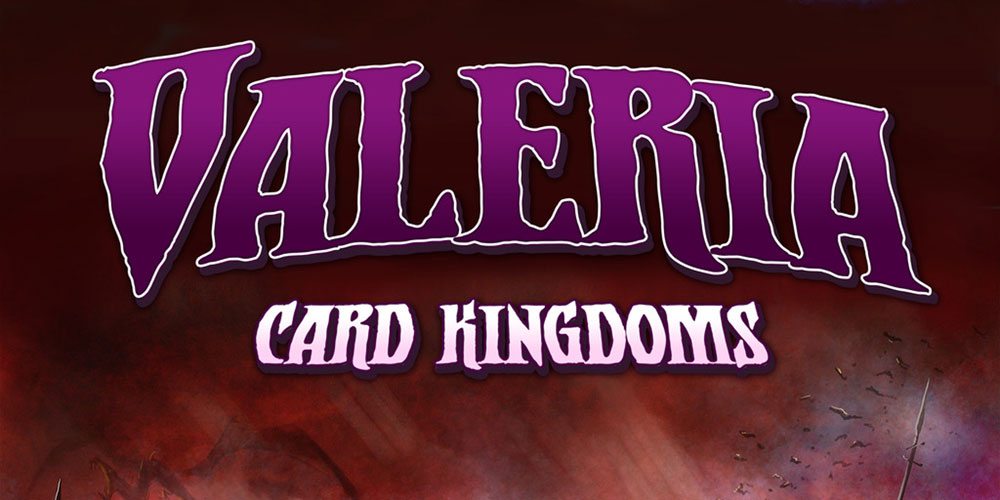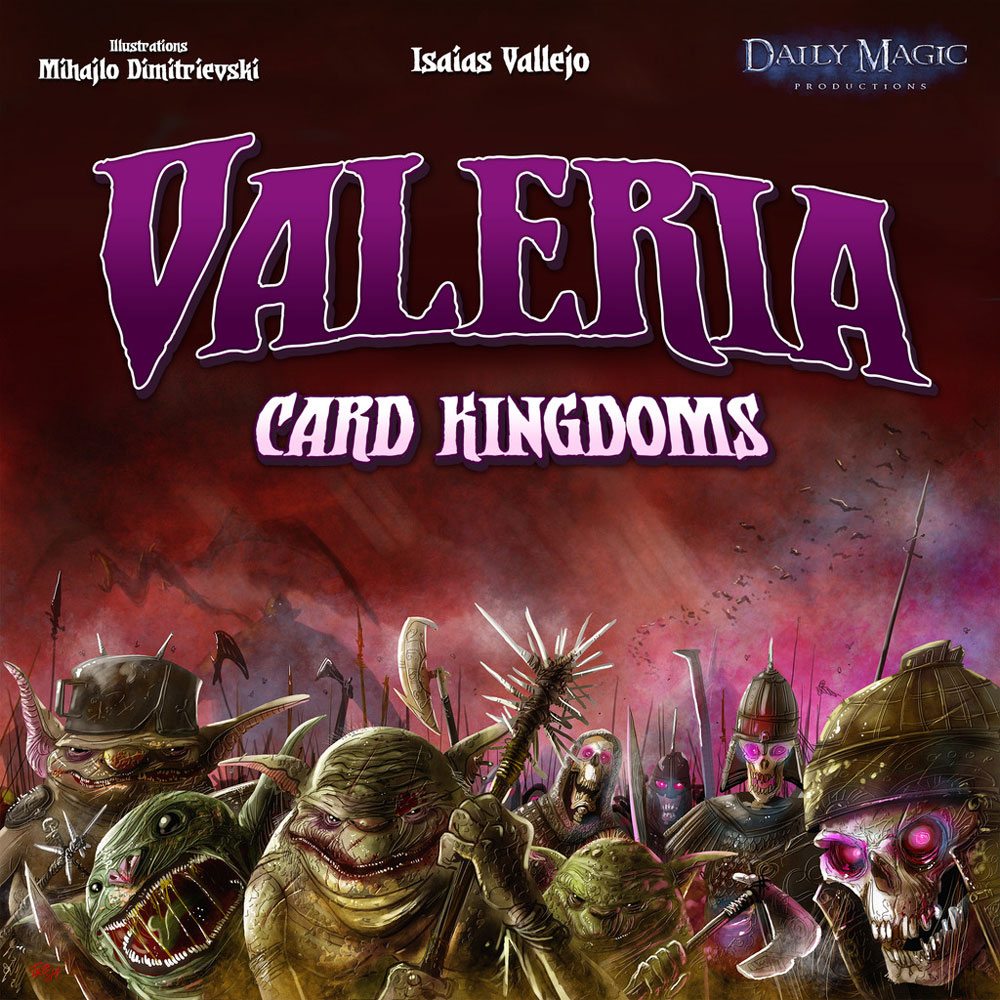Hordes of monsters are invading, and it’s up to you to defend the kingdom by recruiting citizens to fight. Oh, and while you’re at it, you might as well take control of a few domains, because it never hurts to have a little influence, too. Welcome to Valeria: Card Kingdoms.
At a glance: Valeria: Card Kingdoms is for 2 to 4 players, ages 13 and up, and takes about 45 minutes to play. It is currently seeking funding on Kickstarter, with a pledge of $29 for a copy of the game and an expected delivery date of January 2016. (Pledge $299 to get your likeness on one of the Duke cards, plus a prototype sent to you much earlier so you can start playing right away.) I would say you could probably teach the game to kids as young as 10 (particularly if they’re familiar with Machi Koro) but some of the fantasy artwork may be a little intense for younger players.
New to Kickstarter? Check out our crowdfunding primer.

Components:
- 90 Citizen cards
- 25 Monster cards
- 15 Domain cards
- 8 Duke cards
- 8 Exhausted cards
- 8 Starting cards
- 4 Reference cards
- 2 6-sided dice
- 106 tokens (Gold, Magic, Strength)
I received a demo prototype of Valeria: Card Kingdoms to try out, so my copy isn’t finished quality–the cards were printed and sleeved, and it had light plastic chips instead of cardboard tokens. However, the artwork by Mihajlo “The Mico” Dimitrievski was mostly completed, and it’s really impressive. There are 18 different characters and 15 monsters, not to mention the domains and Dukes, and the illustrations are quite detailed and I like them a lot.
The cards are, for the most part, well-designed, too, with icons and numbers that are pretty easy to parse (other than the teeny question mark hidden on the “any player of your choice” icon). It could help to have some of the icons a little larger, but for the most part everyone seems to get the hang of it pretty quickly. The Gold, Magic, and Strength icons have both different colors and icons so it should be color-blind friendly.
How to play
First, if you’re interested in giving the game a shot yourself, you can download the rules and the print-and-play files here–but be warned, it’s a LOT of cards to print and cut out.
The goal of the game is to score the most points by slaying monsters, buying domains, and special bonuses from your Duke card.
To set up, place the Gold, Magic, and Strength tokens in a supply on the table, and then lay out the center stacks.
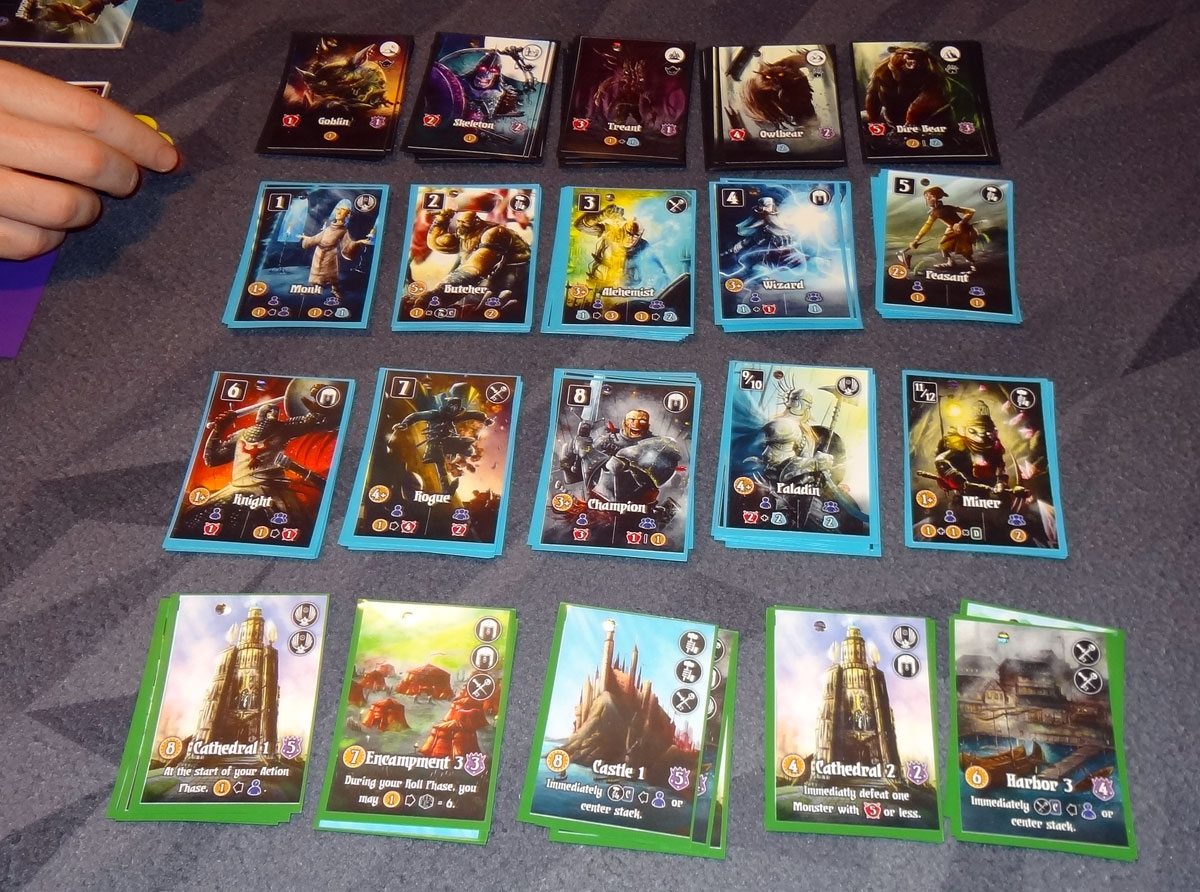
There are five stacks of monsters, each arranged with the lowest value on top. The monsters correspond to different areas, noted by an icon in the top right corner.
Next come the citizens: there are 10 stacks, one for each number (noted in the top left corner of the card). The 5 and 6 are always the Peasant and Knight, respectively, but you’ll get to decide between two citizen types for each of the other numbers. For instance, the #7 could be either a Thief or a Rogue; the citizens you don’t use are returned to the box.
Finally, you set up the Domains. There are 5 stacks of 3 each, with the top card of each stack turned face-up.
Each player starts with a starting Knight, starting Peasant, 2 Duke cards, 2 Gold, and 1 Magic. You look at your Duke cards secretly, choose one to keep, and return the other one to the box. Duke cards award bonus points for acquiring certain things–it may be specific types of citizens, domains, or monsters. The Knight and Peasant are placed in front of you, starting your tableau.
Each turn consists of these phases: Roll, Harvest, Action, End.
Roll: the active player rolls the dice.
Harvest: Each player activates the citizens indicated by the dice–first each individual die, then the sum.
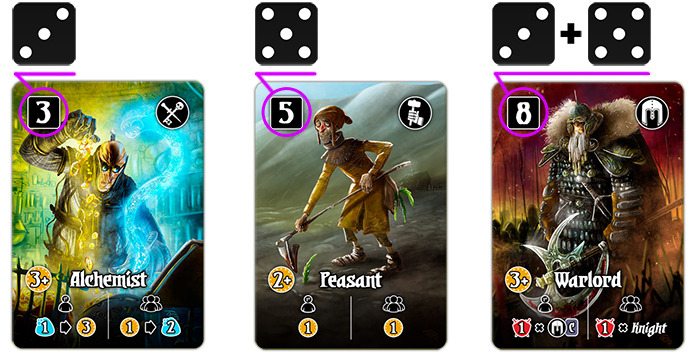
The active player will harvest based on the icons on the left side of the card. All other players will harvest based on the icons on the right side of the card.
Action: The active player then takes 2 actions from the following (actions may be repeated):
- Take 1 Gold, Magic, or Strength.
- Slay a monster.
- Recruit a citizen.
- Buy a domain.
Magic can be used to augment Gold or Strength–each Magic can be worth one Gold or Strength. But you still need to have at least one Gold or Strength; Magic can’t be spent by itself.
You may slay any of the revealed monsters if you have enough Strength (plus Magic) to match the monster’s strength. You get the reward shown at the bottom of the monster card, and then put the monster into your scoring pile.
You may recruit a citizen by paying its Gold cost, plus 1 Gold for each citizen of that type you already have.
You may buy a domain by paying its Gold cost if you have the right types of citizens. There are four types of citizens (marked by the icons at the top right), and you must have citizens matching the icons on the Domain card in order to buy it. Some domains give ongoing abilities, and some give a one-time immediate ability.
End: Pass the dice to the next player.

Any time a center stack runs out, you place an Exhausted card there. When the number of Exhausted cards is twice the number of players, or when the last Monster is slain, the game ends immediately.
You score the points shown on the purple shield icons for monsters and domains. You also get points based on your Duke card, and you get 1 point for every 3 resource tokens you have left.

The Verdict
The first time I heard a description of Valeria: Card Kingdoms, I thought of Machi Koro, another game that includes a tableau of cards activated by rolling dice. Machi Koro was one of my favorite games of 2014, so I was pretty eager to give Valeria a try to see how it compared. There are indeed some similarities in some of the mechanics, but Valeria is definitely its own creature, too, with some added layers.
The biggest difference is the goal of the game: rather than trying to save up enough money to purchase a few specific things, you attack monsters and buy domains for points. In Machi Koro, everything generates money, but not so in Valeria. Because there are different types of resources to be had, it’s not always the best strategy to buy one of every citizen so that every number rolled will activate somebody. Instead, you need to plan out what types of resources you’ll need, and seek out those citizens first. Want to hunt monsters? Make sure you’ve got ways to earn Strength. Want to buy a domain? Check what types of citizens you’ll need for those domains.
I like the way that everyone gets to harvest on every turn, kind of like Settlers of Catan. If you have the right citizens and the right dice rolls, you’ll generate resources even when it’s not your turn. You can play the odds by trying to cover a lot of different numbers, or by getting a bunch of the same thing, hoping to cash in big when that number is rolled.
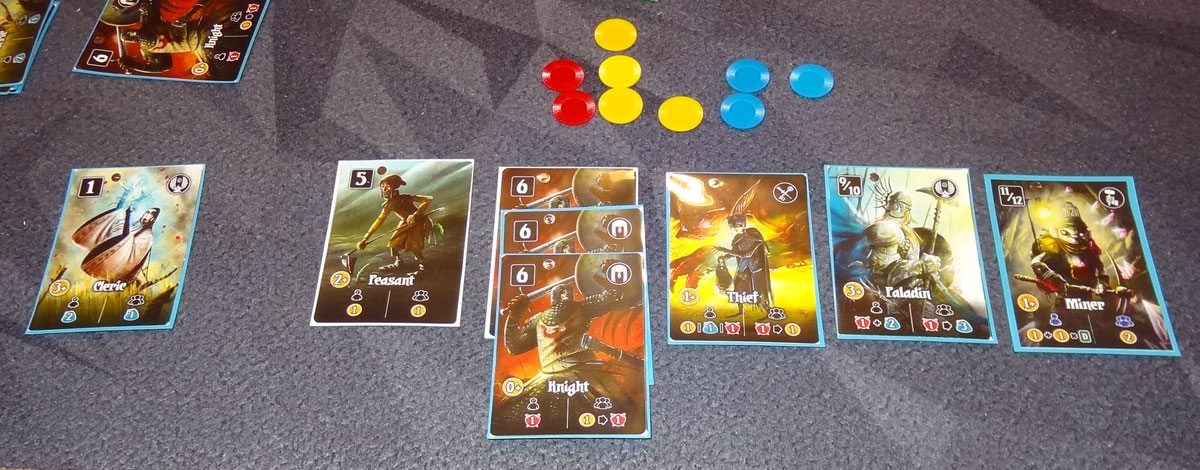
The Dukes are a good touch: since you have some things that will earn you extra points, it can help direct your actions. This is good for two reasons: first, not everyone wants the same things, so it affects the way you compete with each other. But also, when you’re first learning the game and it feels overwhelming to have so many choices, you can look at your Duke card and focus on getting those things. I also like the fact that, although you know whenever somebody slays a monster or buys a domain, you don’t know anyone’s exact score until the game ends.

I also like that there are multiple citizens included for each number. Right now there are two for each number (except the 5 and 6), and I could easily see future expansions adding other options, too. The particular mix of citizens will change your strategy, because you’ll have different ways of getting resources.
I also appreciate that Valeria has undergone a lot of playtesting. In fact, the Kickstarter was pushed back because they wanted more time to tweak some rules, and I was sent an updated prototype after I’d already played a few times. I was really impressed with the changes, which streamlined the game and made it even easier to learn. One player in my gaming group who hadn’t been really fond of it the first time around really enjoyed it after the update.
In terms of complexity, I’d say that it’s a level up from Machi Koro. It’s still pretty accessible and I think it’s something that casual gamers can pick up fairly easily, with enough depth for gamers that like heavier games, too. The fantasy theme and artwork might restrict its audience somewhat, but I think it’s done really well. (My kids may still prefer the world of Machi Koro, but I’m happy playing both.) There is, of course, an element of luck in the dice-rolling, as well as the randomization of Dukes and domains, but everything else is open information, and it’s up to the player to choose how they want to play the odds.
Overall, Valeria: Card Kingdoms is a really solid game that I’m eager to play more, and I highly recommend giving it a try. It’s a shame that you’ll have to wait so long to play it, but I think it’s well worth it. (If you just can’t wait, remember the Print and Play. In addition, if you’re in the Pacific Northwest, look for Isaias Vallejo at Emerald City Comicon and GameStorm, where he will be running demos and giving away some prototypes as prizes!)
For more information or to make a pledge, check out the Kickstarter campaign, just launched today.
